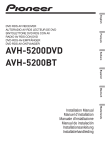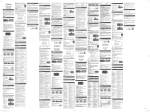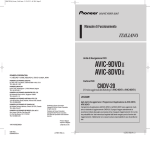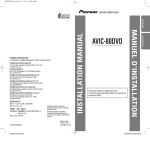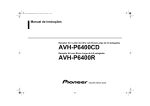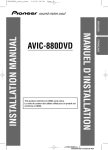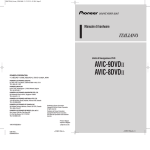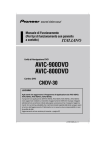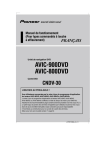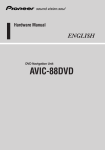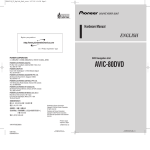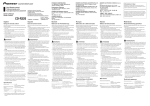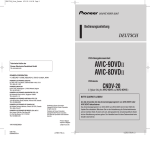Download CD-VC1 - Pioneer
Transcript
A B C D VOICE COMMAND PACK WARNING ENSEMBLE DE COMMANDE VOCALE E F G H Owner’s Manual Mode d’emploi Fig.1, Abb.1, Afb.1 CD-VC1 1 2 3 4 8 5 6 7 Fig.2, Abb.2, Afb.2 4-1, MEGURO 1-CHOME, MEGURO-KU, TOKYO 153-8654, JAPAN PIONEER ELECTRONICS (USA) INC. This device complies with Part 15 of the FCC Rules. Operation is subject to the following two conditions: (1) This device may not cause harmful interference, and (2) this device must accept any interference received, including interference that may cause undesired operation. P.O. Box 1540, Long Beach, California 90801-1540, U.S.A. TEL: (800) 421-1404 PIONEER EUROPE NV Haven 1087, Keetberglaan 1, B-9120 Melsele, Belgium TEL: (0) 3/570.05.11 PIONEER ELECTRONICS ASIACENTRE PTE. LTD. 253 Alexandra Road, #04-01, Singapore 159936 TEL: 65-6472-1111 Infomation to User Alteration or modifications carried out without appropriate authorization may invalidate the user’s right to operate the equipment. PIONEER ELECTRONICS AUSTRALIA PTY. LTD. 178-184 Boundary Road, Braeside, Victoria 3195, Australia TEL: (03) 9586-6300 300 Allstate Parkway, Markham, Ontario L3R OP2, Canada TEL: (905) 479-4411 PIONEER ELECTRONICS DE MEXICO, S.A. de C.V. Blvd. Manuel Avila Camacho 138 10 piso Col. Lomas de Chapultepec, Mexico, D.F. 11000 TEL: 55-9178-4270 Published by Pioneer Corporation. Copyright © 2003 by Pioneer Corporation. All rights reserved. Publication de Pioneer Corporation. Copyright © 2003 Pioneer Corporation. Tous droits de reproduction et de traduction réservés. Printed in China Imprimé en Chine < KNKFF > < 03L00000 > <CZR5014-A> E • Keep the lithium battery out of reach of children. Should the battery be swallowed, immediately consult a doctor. • Avoid installing this unit in such a location where the operation of the steering wheel and the gearshift lever may be prevented. Otherwise, it may result in a traffic accident. • Do not operate this unit while manipulating the steering wheel. Or it might result in a traffic accident. • In case you operate this unit unavoidably during driving, neglect looking ahead carefully. Otherwise, you will be ready to run the risk of being involved in a traffic accident. • If any of the following troubles occurs, immediately stop the use of this unit and consult with a dealer from whom you purchased this unit: – the unit is smoking. – the unit is emitting abnormal odor. – a foreign object has entered the unit. – liquid has been spilled on or into the unit. If you continue to use this unit without a remedy, the unit may be damaged badly, which leads to a serious accident or fire. CAUTION PIONEER CORPORATION PIONEER ELECTRONICS OF CANADA, INC. <ENGLISH> WARNING: Handling the cord on this product or cords associated with accessories sold with the product will expose you to lead, a chemical known to the State of California and other governmental entities to cause cancer and birth defects or other reproductive harm. Wash hands after handling. • Do not recharge, disassemble, heat or dispose of battery in fire. • Use a CR2032 (3 V) lithium battery only. Never use other types of battery with this unit. • Do not handle the battery with metallic tools. • Do not store the lithium battery with metallic materials. • When disposing of used batteries, please comply with governmental regulations or environmental public institution’s rules that apply in your country/area. • Always check carefully that you are loading battery with its (+) and (–) poles facing in the proper directions. • Install this unit using only the parts supplied with this unit. If other parts are used, this unit may be damaged or dismounted itself, which leads to an accident or trouble. • Install this unit as required by this manual. Failure to do so may cause an accident. • Do not install this unit near the doors where rainwater is likely to be spilled on the unit. Incursion of water into the unit may cause smoking or fire. • The volume of the car stereo should be so adjusted that you can hear a loud sound occurring outside your car. If any happening sound outside your car is deafened by music from the car stereo when you are driving, this condition can be a factor of being involved in a traffic accident. • Do not leave this unit free inside the car. When the car stops or turns a curve, the unit might drop on the floor. If the unit is rolled and put under the brake pedal, it might prevent the driver from braking well, causing a serious trouble. Be sure to fix this unit to the steering wheel. • Do not disassemble or modify this unit. To do so may cause a fault. Accessories A Remote control unit × 1 B Holder × 1 C Belt × 2 D Microphone × 1 E Mic clip × 1 F Double-sided tape × 1 G Clamper × 5 H Lithium battery (CR2032, 3V) × 1 Operation mode By switching the Operation mode (Main mode, Navigation mode) you can use one remote control to operate different equipment. Main mode : Operates Pioneer AV Head Unit (e.g. AVH-P7500DVD, AVH-P6500DVD, AVH-P6400CD, AVH-P6400R) Main mode operation (Fig 2) q NAVI/AUDIO button Pressing this button switches the Operation mode. w VOICE button You can use the VOICE button to start voice recognition, allowing you to operate the Navigation System by speech. e SRC (SOURCE) button Switches between sources and switches power ON/OFF. (Depending on the connected units, operation may differ slightly.) r 5, ∞, 2, 3 button Operates the same as the Head Unit’s 5, ∞, 2, 3 button or the Joystick. t POS button Press this button to view the map or return to guidance. Also, when the map is scrolling, pressing this button returns to the map display of your surroundings. u Transmitter This transmits the remote control signals. i +/– button The Pioneer AV Head Unit’s sound volume can be adjusted. Navigation mode (navigation oper ation) (Fig 2) The SRC (SOURCE) button, and 2 / 3 buttons are not used in Navigation mode. Navigation mode : Navigation operation q NAVI/AUDIO button Pressing this button switches the Operation mode. Before you begin, set the Operation mode switching method. The Operation mode switching changes in accordance with the settings below. w VOICE button You can use the VOICE button to start voice recognition, allowing you to operate the Navigation System by speech. Switching method Main mode J Navigation mode Navigation mode only Setting method Press the VOICE button while pressing the GUIDE/TRAFFIC button. Press the SRC (SOURCE) button while pressing the GUIDE/TRAFFIC button. When using with the Pioneer AV Head Unit, set to Main mode. If you wish to use Navigation operation only, set to Navigation mode. (‘‘Main mode’’ is default or factory setting.) r 5/∞ button The map can be enlarged or reduced. If a menu list extends over several pages, switch to the previous page or the next page. t POS button Press this button to view the map or return to guidance. Also, when the map is scrolling, pressing this button returns to the map display of your surroundings. y GUIDE/TRAFFIC button Press this button if you want to hear the voice guidance again. If this button is pressed for more than two seconds, you can listen to traffic information on your route (where available). u Transmitter This transmits the remote control signals. i +/– button The volume of the navigation guide voice can be adjusted. Microphone After pressing the VOICE button to start voice operation, this microphone hears your commands. For further information, refer to the Navigation System manual. <ESPAÑOL> ADVERTENCIA • Mantenga la pila de litio fuera del alcance de los niños. Si la pila fuese tragada, consulte con un médico inmediatamente. • Evite instalar esta unidad en un lugar en el que la operación del volante y la palanca de cambio sea impedida. De otra manera, podría resultar en un accidente de tráfico. • No opere esta unidad mientras maneja el volante, o podría resultar en un accidente de tráfico. • En el caso de que inevitablemente opere esta unidad mientras conduce, mire hacia adelante cuidadosamente. De otro modo, prepárese para correr el riesgo de verse implicado en un accidente de tráfico. • Si ocurriera cualquiera de los siguientes problemas, inmediatamente deje de usar esta unidad y consulte con el concesionario a quien comprù esta unidad: – la unidad emite humo. – la unidad emite olores anormales. – un objeto extraño ha entrado en la unidad. – se ha derramado líquido sobre o dentro de la unidad. Si continúa utilizando esta unidad sin reparar el fallo, la unidad se dañará aún más, lo que llevará a un serio accidente o incendio. PRECAUCION • No recargue, desarme, caliente ni tire la pila al fuego. • Utilice solamente una pila de litio CR2032 (3 V). No utilice otros tipos de pilas con esta unidad. • No toque la pila con instrumentos metálicos. • No guarde la pila de litio con materiales metálicos. • Al descartarse de las pilas usadas, cumpla con las reglas gubernamentales o reglas de la institución pública del medio ambiente aplicables en su país/área. • Siempre revise cuidadosamente que está cargando la pila con los polos (+) y (–) dirigidos en las direcciones correctas. • Instale esta unidad utilizando solamente las piezas provistas con la misma. Si se utilizara otras piezas, la unidad podría deñarse o desarmarse por si misma, lo que conllevaría a un accidente o problema. • Instale esta unidad tal como se indica en el manual. Si falla en efectuar la instalación así, podría causar un accidente. • No instale esta unidad cerca de las puertas donde sea probable que el agua de la lluvia se derrame sobre la unidad. La incursión de agua dentro de la unidad podría causar la emisión de humos o incendio. • El volumen del estéreo del coche deberá ajustarse de tal forma que se pueda escuchar un sonido fuerte que ocurre fuera del coche. Si un sonido de fuera del coche fuese ensordecido por la música del estéreo cuando está conduciendo, esta condición podría ser un factor de la causa de un accidente de tráfico. • No deje esta unidad libre dentro del coche. Cuando el coche se detenga o voltee una curva, la unidad podría caerse en el piso. Si la unidad rodara y se pusiera debajo del pedal del freno, esto podría evitar que el conductor haga el frenado debidamente, causando serios problemas. Asegúrese de fijar esta unidad al volante. • Ne desarme ni haga cambios en esta unidad, si no podría resultar en fallos. Accesorios A Unidad de control remoto × 1 B Soporte × 1 C Correa × 2 D Micrófono × 1 E Sujetador de micrófono × 1 F Cinta con adhesivo en ambos lados × 1 G Retén × 5 H Pila de litio (CR2032, 3V) × 1 Modo de funcionamiento Al activar el modo de funcionamiento (modo principal, modo de navegación), puede utilizar un control remoto para utilizar otro equipo. Modo principal: Permite operar la unidad de control AV de Pioneer (p. ej. AVH-P7500DVD, AVH-P6500DVD, AVHP6400CD, AVH-P6400R) Modo de navegación: Funcionamiento de navegación En primer lugar, configure el método de conmutación del modo de funcionamiento. La conmutación del modo de funcionamiento cambia de acuerdo con las opciones de configuración descritas a continuación. Método de conmutación Modo principal J Modo de navegación Modo de navegación solamente Método de configuración Pulse el botón VOICE a la vez que el botón GUIDE/TRAFFIC. Pulse el botón SRC (SOURCE) a la vez que el botón GUIDE/TRAFFIC. Cuando utilice el control remoto con la unidad de control AV de Pioneer, configure la opción al Modo principal. Si desea utilizar únicamente el funcionamiento de navegación, configure la opción al Modo navegación. (El “Modo principal” es el valor de configuración predeterminado o de fábrica.) Funcionamiento en modo principal (Fig 2) q Botón NAVI/AUDIO Al pulsar este botón se conecta el modo de funcionamiento. w Botón VOICE Puede utilizar el botón VOICE para iniciar el reconocimiento de voz, lo que le permitirá controlar el sistema de navegación mediante la voz. e Botón SRC (SOURCE) Alterna entre las fuentes y conecta/desconecta (ON/OFF) la alimentación. (Dependiendo de las unidades conectadas, el funcionamiento puede diferir ligeramente.) r Botón 5, ∞, 2, 3 Funciona del mismo modo que el botón 5, ∞, 2, 3 de la unidad de control o que el mando omnidireccional. t Botón POS Si pulsa este botón verá el mapa o volverá al modo de guía. Además, cuando se mueve el mapa, al pulsar este botón se regresa a la pantalla en la que el mapa muestra los alrededores del vehículo. u Transmisor Transmite las señales del control remoto. i Botón +/– El volumen del sonido de la unidad de control AV de Pioneer puede ajustarse. Modo de navegación (funcionamiento de navegación) (Fig 2) El botón SRC (SOURCE) y los botones 2 / 3 no se utilizan en el modo de navegación. q Botón NAVI/AUDIO Al pulsar este botón se conecta el modo de funcionamiento. w Botón VOICE Puede utilizar el botón VOICE para iniciar el reconocimiento de voz, lo que le permitirá controlar el sistema de navegación mediante la voz. r Botón 5/∞ El mapa puede ampliarse o reducirse. Si una lista de menú ocupa varias páginas, desplácese a la página anterior o a la página siguiente. t Botón POS Si pulsa este botón verá el mapa o volverá al modo de guía. Además, cuando se mueve el mapa, al pulsar este botón se regresa a la pantalla en la que el mapa muestra los alrededores del vehículo. y Botón GUIDE/TRAFFIC Presione este botón si desea oír de nuevo las instrucciones de la guía de voz. Si el botón se pulsa durante más de dos segundos, puede escuchar información del tráfico en su itinerario (donde esté disponible). u Transmisor Transmite las señales del control remoto. i Botón +/– El volumen de la voz de guía de navegación puede ajustarse. Micrófono Después de pulsar el botón VOICE para iniciar la operación por voz, este micrófono capta sus órdenes. Para obtener más información, consulte el manual del Sistema de navegación. <DEUTSCH> WARNUNG • Die Lithiumbatterie Außer Reichweite Kleiner Kinder halten. Sollte die Batterie verschluckt werden, sofort einen Arzt Aufsuchen. • Installieren Sie dieses Gerät nicht an einer Stelle, wo die Betätigung des Lenkrads und Schalthebels behindert werden kann, da es in diesem Fall leicht zu einem Verkehrsunfall kommen kann. • Betätigen Sie dieses Gerät nicht, während Sie das Lenkrad bewegen. Dadurch könnte es zu einem Verkehrsunfall kommen. • Sollte eine Bedienung dieses Geräts während des Fahrens unvermeidlich sein, schauen Sie trotzdem immer nach vorn auf die Straße. Andernfalls können Sie leicht in einen Verkehrsunfall verwickelt werden. • Stellen Sie in den folgenden Störungsfällen die Benutzung dieses Geräts sofort ein und wenden Sie sich an den Händler, bei dem Sie es gekauft haben: – us dem Gerät kommt Rauch. – Das Gerät gibt einen anomalen Geruch ab. – Ein Fremdkörper ist in das Gerät eingedrungen. – Flüssigkeit ist auf oder in das Gerät verschüttet worden. Wenn Sie das Gerät in diesen Fällen weiterhin benutzen, kann es schwer beschädigt werden und einen ernsten Unfall oder Brand verursachen. VORSICHT • Die Batterie nicht aufladen, auseinandernehmen, erhitzen oder ins Feuer werfen. • Nur eine Lithiumbatterie vom Typ CR2032 (3 V) verwenden. Niemals einen anderen Batterietyp für dieses Gerät verwenden. • Die Batterie nicht mit Metallwerkzeugen handhaben. • Die Batterie nicht zusammen mit Metallgegenständen lagern. • Gebrauchte Batterien müssen in Übereinstimmung mit den Umweltschutzvorschriften des jeweiligen Landes/Gebiets entsorgt werden. • Beim Einsetzen der Batterie immer darauf achten, daß Pluapol (+) und Minuspol (–) in die richtige Richtung weisen. • Für die Installation dieses Geräts sollten nur die mitgelieferten Teile benutzt werden. Bei Verwendung anderer Teile kann das Gerät beschädigt werden oder sich lösen, was zu einem Unfall oder Problemen führen kann. • Dieses Gerät ist entsprechend den hier gegebenen Anweisungen zu installieren. Andernfalls kann es zu einem Unfall kommen. • Installieren Sie dieses Gerät nicht in der Nähe der Türen, wo Regenwasser auf das Gerät spritzen kann. In das Gerät eindringendes Wasser kann Rauchentwicklung oder einen Brand verursachen. • Die Lautstärke der Autostereo-Anlage sollte so eingestellt werden, daß Sie laute Geräusche außerhalb Ihres Autos hören können. Wenn die Musik in Ihrem Auto beim Fahren so laut ist, daß Sie alarmierende Außengeräusche nicht mehr hören, kann das dazu führen, daß Sie in einen Verkehrsunfall verwickelt werden. • Lassen Sie dieses Gerät nicht frei im Auto liegen, da es in diesem Fall beim Bremsen oder Kurvenfahren auf den Boden fallen kann. Wenn das Gerät unter das Bremspedal rollt, kann es den Fahrer beim Bremsen behindern, was einen schweren Unfall zur Folge haben kann. Besfestigen Sie dieses Gerät unbedingt am Lenkrad. • Dieses Gerät darf nicht auseinandergenommen oder modifiziert werden. Dadurch könnte ein Betriebsversagen vetursacht werden. Zubehör A Fernbedienung × 1 B Halter × 1 C Riemen × 2 D Mikrofon × 1 E Mikrofonhalter × 1 F Doppelseiting haftendes Klebeband × 1 G Klemme × 5 H Lithium-Batterie (CR2032, 3V) × 1 Betriebsart Durch Umschalten des Betriebsmodus (Standardbetrieb, Navigationsbetrieb) können Sie mit nur einer Fernbedienung verschiedene Geräte steuern. Standardbetrieb: Zur Steuerung des Pioneer AV-Hauptgeräts (z. B. AVHP7500DVD, AVH-P6500DVD, AVH-P6400CD, AVHP6400R) Navigationsbetrieb: Zum Navigieren Wählen Sie zunächst den Umschaltmodus für die Betriebsarten aus. Folgende Einstellungen stehen zur Verfügung: Umschaltmodus Standardbetrieb J Navigationsbetrieb Nur Navigationsbetrieb So stellen Sie den Umschaltmodus ein Drücken Sie gleichzeitig die VOICE-Taste und die GUIDE/TRAFFIC-Taste. Drücken Sie gleichzeitig die SRC (SOURCE)Taste und die GUIDE/TRAFFIC-Taste. Wenn Sie das Gerät mit dem Pioneer AV-Hauptgerät verwenden, stellen Sie den Standardmodus ein. Wenn Sie lediglich den Navigationsbetrieb nutzen möchten, stellen Sie den Navigationsmodus ein. (Der "Standardmodus" ist bereits werksseitig voreingestellt.) Standardbetrieb (Abb 2) q NAVI/AUDIO-Taste Durch Drücken dieser Taste schalten Sie in eine andere Betriebsart. w VOICE-Taste Durch Drücken der VOICE-Taste schalten Sie die Sprachsteuerung ein. Bei eingeschalteter Sprachführung können Sie das Navigationssystem ausschließlich durch Ihre Stimme steuern. e SRC (SOURCE)-Taste Schaltet zwischen Programmquellen um und dient zum Ein- und Ausschalten. (Je nach angeschlossenen Geräten kann der Betrieb etwas abweichen.) r 5, ∞, 2, 3 -Taste Die Tasten haben die gleichen Funktionen wie die Pfeiltasten 5, ∞, 2, 3 des Hauptgeräts oder der Joystick. t POS-Taste Drücken Sie diese Taste, um die Karte anzuzeigen oder zur Zielführung zurückzukehren. Während des Blätterns durch die Karte kehren Sie durch Drücken dieser Taste zur Anzeige der Umgebungskarte zurück. u Transmitter Überträgt die Signale der Fernbedienung. i +/– -Taste Sie können die Lautstärke des Pioneer AVHauptgerätes nach Wunsch einstellen. Navigationsbetrieb (Navigieren) (Abb 2) Im Navigationsbetrieb werden die SRC (SOURCE)Taste sowie die Pfeiltasten 2 / 3 nicht verwendet. q NAVI/AUDIO-Taste Durch Drücken dieser Taste schalten Sie in eine andere Betriebsart. w VOICE-Taste Durch Drücken der VOICE-Taste schalten Sie die Sprachsteuerung ein. Bei eingeschalteter Sprachführung können Sie das Navigationssystem ausschließlich durch Ihre Stimme steuern. r 5/∞ -Taste Zum Vergrößern oder Verkleinern der Karte. Bei mehrseitigen Menüs in Listenform Blättern zur vorherigen oder nächsten Seite. t POS-Taste Drücken Sie diese Taste, um die Karte anzuzeigen oder zur Zielführung zurückzukehren. Während des Blätterns durch die Karte kehren Sie durch Drücken dieser Taste zur Anzeige der Umgebungskarte zurück. y GUIDE/TRAFFIC-Taste Drücken Sie diese Taste, wenn Sie die Sprachführung wieder hören wollen. Wenn Sie diese Taste länger als zwei Sekunden drücken, können Sie die Verkehrsinformationen für Ihre Fahrtroute hören (wo verfügbar). u Transmitter Überträgt die Signale der Fernbedienung. i +/– -Taste Einstellen der Ansagelautstärke des Navigationssystems. Mikrofon Nach der Aktivierung der Sprachführung durch Drücken der VOICE-Taste sprechen Sie die Befehle in dieses Mikrofon. Weitere Informationen finden Sie in der Bedienungsanleitung des Navigationssystems. <FRANÇAIS> AVERTISSEMENT • Garder la pile au lithium hors d‘atteinte d‘enfants. Si une pile est avalée, consulter immediatement un medecin. • Eviter d’installer cette unité dans un endroit où elle peut gêner l’utilisation du volant de direction et du levier de commande des vitesses. Cela pourrait provoquer un accident de la circulation. • Ne pas utiliser cette unité tout en manipulant le volant. Cela pourrait provoquer un accident. • Au cas où cette unité doit absolument être utilisée en conduisant, ne pas quitter la route des yeux. Sinon il y a un risque d’être impliqué dans un accident. • Si l’un des problèmes suivants se produit, arrêter immédiatement d’utiliser cette unité et prendre contact avec le distributeur où l’unité a été achetée: – de la fumée sort de l’unité. – l’unité dégage une odeur anormale. – un objet a pénétré dans l’unité. – un liquide a été renversé sur ou dans l’unité. Si cette unité continue à être utilisée sans prendre aucune mesure, elle peut être sérieusement endommagée et provoquer un grave accident ou un incendie. ATTENTION • Ne pas recharger, demonter. chauffer une pile ni la jeter dans un feu. • N’utiliser qu’une pile au lithium CR2032 (3 V) N’utiliser. Jamais d’autre type de pile avec cette unité. • Ne pas manipuler la pile avec un outil métalligue. • Ne pas ranger une pile au lithium avec des objects métalligues. • Lors de la mise au rebut des piles usagées, respectez les règlements en vigueur dans le pays en matière de conservation ou de protection de l’environnement. • Verifier toujours soigneusement de charger la pile avec ses poles (+) et (–) dans le bon sens. • N’installer cette unité qu’en utilisant les pièces qui sont fournies avec celle-ci. Si d’autres pièces sont utilisées, l’unité peut être endommagée ou se démonter, ce qui peut provoquer un accident ou un problème. • Installer cette unité conformément à ce manuel. Sinon cela pourrait provoquer un accident. • Ne pas installer cette unité près des portes où de l’eau de pluie peut la mouiller. La pénétration d’eau dans l’unité peut provoquer de la fumée ou un incendie. • Le volume de l’auto-stéréo doit être réglé de sorte à pouvoir entendre un bruit fort à l’extérieur de la voiture. Si un bruit se produisant à l’extérieur de la voiture est étouffé par la musique de l’auto-stéréo pendant la conduite, cela peut être un facteur contribuant à être impliqué dans un accident. • Ne pas laisser cette unité non fixée dans la voiture. Lors d’un arrêt ou d’un virage, elle peut tomber sur le plancher. Si l’unité roule et se place sous la pédale de frein, elle peut empêcher le conducteur de bien freiner et provoquer un sérieux problème. Toujours fixer cette unité au volant de direction. • Ne pas démonter ni modifier cette unité. Cela pourrait la faire fonctionner mal. Accessoires A Télécommande × 1 B Support × 1 C Courroie × 2 D Microphone × 1 E Attache du microphone × 1 F Ruban double face × 1 G Collier × 5 H Pile au lithium (CR2032, 3V) × 1 Mode de fonctionnement En activant le mode de fonctionnement (mode principal, mode navigation), vous pouvez utiliser la télécommande pour différents équipements. Mode principal : Opération de l’appareil central AV (par ex. AVHP7500DVD, AVH-P6500DVD, AVH-P6400CD, AVHP6400R) q Touche NAVI/AUDIO En appuyant sur cette touche, vous changez de mode de fonctionnement. w Touche VOICE Vous pouvez utiliser cette touche VOICE pour démarrer la reconnaissance vocale vous permettant de commander le système de navigation vocalement. e Touche SRC (SOURCE) Cette touche permet de passer d’une source à l’autre et de marche (ON) à arrêt (OFF). (Selon les unités reliées, le rôle de cette touche peut légèrement différer.) r Touche 5, ∞, 2, 3 Effectue les mêmes opérations que la touche 5, ∞, 2, 3 ou la manette de l’appareil central. t Touche POS Appuyez sur cette touche pour visualiser la carte ou retourner au guidage. De plus, lor sque la carte défile, le fait d’appuyer sur cette touche permet de retourner à l’affichage de la carte de votre environnement. u Transmetteur Il transmet les signaux de commande à distance. i Touche +/– Le volume de l’appareil central AV Pioneer peut être réglé. Mode navigation : Opération de navigation Tout d’abord, réglez la méthode de commutation du mode de fonctionnement. La commutation du mode de fonctionnement change en fonction des paramètres, comme indiqué ci-dessous. Méthode de commutation Mode principal J Mode navigation Uniquement le mode navigation Fonctionnement du mode principal (Fig 2) Méthode de réglage Pressez et maintenez la touche GUIDE/TRAFFIC et pressez la touche VOICE. Pressez et maintenez la touche GUIDE/TRAFFIC et pressez la touche SRC (SOURCE). Lors de l’utilisation avec l’appareil central AV Pioneer, sélectionnez le mode principal. Si vous souhaitez seulement utiliser la fonction navigation, sélectionnez le mode Navigation. (“Mode principal” par défaut ou paramétrage d’usine.) Mode navigation (opération de navigation) (Fig 2) La touche SRC (SOURCE) et les touches 2 / 3 ne sont pas utilisées dans le mode navigation. q Touche NAVI/AUDIO En appuyant sur cette touche, vous changez de mode de fonctionnement. w Touche VOICE Vous pouvez utiliser cette touche VOICE pour démarrer la reconnaissance vocale vous permettant de commander le système de navigation vocalement. r Touche 5/∞ La carte peut être élargie ou réduite. Si une liste de menu s’étend au-delà de plusieurs pages, cette touche permet de passer à la page précédente ou suivante. t Touche POS Appuyez sur cette touche pour visualiser la carte ou retourner au guidage. De plus, lor sque la carte défile, le fait d’appuyer sur cette touche permet de retourner à l’affichage de la carte de votre environnement. y Touche GUIDE/TRAFFIC Appuyez sur cette touche si vous voulez réécouter le guidage vocal. Si vous appuyez plus de deux secondes sur cette touche, vous pouvez écouter les informations sur le trafic routier de votre itinéraire (si elles sont disponibles). u Transmetteur Il transmet les signaux de commande à distance. i Touche +/– Le volume de la voix du guide de navigation peut être réglé. Microphone Après avoir appuyé sur la touche VOICE pour démarrer le fonctionnement de la voix, ce microphone entend vos ordres. Pour obtenir des informations supplémentaires, veuillez consulter les manuels du Système de Navigation. <ITALIANO> AVVERTIMENTO • Tenere la pila al litio fuori dalla portata dei bambini. Se si ingerisce accidentalmente la pila, consultare immediatamente un medico. • Evitare di installare questa unità in luoghi dove possa interferire con l’uso del volante o della leva del cambio. Altrimenti ne possono risultare incidenti stradali. • Non usare questa unità mentre si gira il volante, altrimenti potrebbe verificarsi un incidente stradale. • Nel caso sia inevitabile usare l’unità durante la guida, non trascurare di guardare la strada. Altrimenti si corre il rischio di essere coinvolti in incidenti stradali. • Nel caso si verifichi uno dei seguenti problemi, cessare immediatamente l’uso dell’unità e consultare il rivenditore presso cui è avvenuto l’acquisto. – L’unità emette fumo. – L’unità emette odori strani. – Un oggetto estraneo è penetrato nell’unità. – Liquido è stato rovesciato su o dentro l’unità. Se si continua ad usare l’unità senza porre rimedio al problema, l’unità può essere seriamente danneggiata, causando seri incidenti o incendi. ATTENZIONE • Non ricaricare la pila, non smontarla, non esporla al calore e non eliminarla gettandola nel fuoco. • Usare soltanto una pila al litio CR2032 (3 V). Non usare mai pile di tipo diverso con questa unità. • Non prendere la pila servendosi di atterezzi metallici. • Non riporre la pila al litio insieme a materiali metallici. • Per eliminare le batterie usate, rispettare i regolamenti stabiliti dal governo o dagli enti pubblici per la tutela dell’ambiente applicabili nel vostro paese/area geografica. • Fare sempre attenzione ad inserire la pila con i suoi poli (+) e (–) rivolti nella direzione corretta. • Installare l’unità usando solo le parti in dotazione all’unità. Se si usano altre parti, questa unità può essere danneggiata o smontata, causando incidenti o problemi. • Installare l’unità come precisato nel manuale. Altrimenti potrebbero verificarsi incidenti. • Non installare l’unità vicino alle portiere dove acqua piovana possa essere rovesciata sull’unità. La penetrazione di acqua nell’unità può causare l’emissione di fumo o incendi. • Il volume dell’autostereo deve essere regolato in modo che sia possibile sentire forti suoni originati fuori dall’auto. Se suoni originati fuori dall’auto sono coperti dallla musica dell’autostereo durante la guida, questo può portare ad incidenti stradali. • Non lasciare l’unità libera all’interno dell’auto. Quando si frena o si esegue una curva l’unità potrebbe cadere. Se l’unità va a finire sotto il pedale del freno può impedire al conducente di frenare bene e causare seri problemi. Assicurarsi di fissare l’unità al volante. • Non smontare o modificare questa unità. Ciò potrebbe causare guasti. Accessori A Unità telecomando × 1 B Supporto × 1 C Cinghia × 2 D Microfono × 1 E Fermaglio microfono × 1 F Nastro a doppio lato adesivo × 1 G Fermafilo × 5 H Pila al Litio (CR2032, 3V) × 1 Modo di funzionamento Commutando il Modo di funzionamento (modo principale, modo navigazione) potete usare un telecomando per azionare diverse apparecchiature. Modo principale : Aziona l’apparecchio principale Pioneer AV (es. AVHP7500DVD, AVH-P6500DVD, AVH-P6400CD, AVHP6400R) Modo navigazione : Funzionamento navigazione Prima di tutto, impostare il metodo di commutazione del Modo di funzionamento. La commutazione del Modo di funzionamento varia secondo le impostazioni come qui di seguito descritto. Metodo di commutazione Modo principale J Modo navigazione Soltanto modo navigazione Metodo di impostazione Premere il tasto VOICE mentre si preme il tasto GUIDE/TRAFFIC. Premere il tasto SRC (SOURCE) mentre si preme il tasto GUIDE/TRAFFIC. Quando si usa l’apparecchio principale Pioneer AV, selezionare il modo Principale. Desiderando utilizzare solamente il funzionamento navigazione, selezionare il modo Navigazione. (“Modo manuale” è l’impostazione predefinita o preimpostata in fabbrica). Funzionamento Modo principale. (Fig 2) q Tasto NAVI/AUDIO Premendo questo tasto si commuta il Modo di funzionamento. w Tasto VOICE Potete usare il tasto VOICE per avviare il riconoscimento vocale, che consente di azionare il Sistema di Navigazione parlando. e Tasto SRC (SOURCE) Commuta tra le sorgenti e accende/spegne (ON/OFF). (in base alle unità collegate, il funzionamento può essere leggermente diverso). r Tasto 5, ∞, 2, 3 Agisce nello stesso modo del tasto 5, ∞, 2, 3 dell’apparecchio principale o del Joystick. t Tasto POS Premere questo tasto per visualizzare la cartina o ritornare alla guida. Inoltre, quando la cartina sta scorrendo, premendo questo tasto si ritorna alla visualizzazione della cartina dei Vostri dintorni. u Trasmettitore Trasmette i segnali del telecomando. i Tasto +/– Può essere regolato il volume audio dell’unità principale Pioneer AV. Modo navigazione (funzionamento navigazione) (Fig 2) Il tasto SRC (SOURCE) ed i tasti 2 / 3 nel Modo navigazione non sono utilizzati. q Tasto NAVI/AUDIO Premendo questo tasto si commuta il Modo di funzionamento. w Tasto VOICE Potete usare il tasto VOICE per avviare il riconoscimento vocale, che consente di azionare il Sistema di Navigazione parlando. r Tasto 5/∞ La cartina può essere ingrandita o ridotta. Se un elenco menu si estende su diverse pagine, passare alla pagina precedente o alla pagina successiva. t Tasto POS Premere questo tasto per visualizzare la cartina o ritornare alla guida. Inoltre, quando la cartina sta scorrendo, premendo questo tasto si ritorna alla visualizzazione della cartina dei Vostri dintorni. y Tasto GUIDE/TRAFFIC Premere questo tasto se si vuole riascoltare il direzionamento vocale. Se questo tasto viene premuto per più di due secondi, potete ascoltare le informazioni del traffico sul vostro percorso (dove disponibili). u Trasmettitore Trasmette i segnali del telecomando. i Tasto +/– Può essere regolato il volume della voce della guida di navigazione. Microfono Dopo avere premuto il tasto VOICE per avviare il funzionamento vocale, questo microfono ascolta i vostri comandi. Per ulteriori informazioni, fare riferimento al relativo manuale. <NEDERLANDS> WAARSCHUWING • Houd de lithiumbatterij buiten het bereik van kleine kinderen. Raadpleeg direct een arts indien een batterij per ongeluk is ingeslikt. • Installeer de stuurafstandsbediening niet op plaatsen waar het het sturen of de bediening van de versnellingspook en andere mechanismen zou kunnen hinderen. Een verkeerde plaats kan ernstige ongelukken veroorzaken. • Gebruik dit toestel niet terwijl u het stuur beweegt. Dit kan leiden tot een verkeersongeval. • Als u het toestel per ongeluk bedient terwijl u aan het rijden bent, moet u toch uw aandacht bij het verkeer houden. Doet u dit niet, dan loopt u gevaar het slachtoffer te worden van een verkeersongeval. • Als zich een van de volgende problemen voordoet, dient u het gebruik van dit toestel onmiddellijk te staken en de dealer van wie u het gekocht heeft te raadplegen: – er komt rook uit het toestel. – er komt een vreemde geur uit het toestel. – er is een vreemd voorwerp in het toestel terecht gekomen. – er is vloeistof op of in het toestel terecht gekomen. Als u het toestel blijft gebruiken zonder deze problemen te hebben opgelost, kan het toestel ernstig beschadigd raken, hetgeen kan leiden tot een ernstig ongeval of brand. LET OP • Laad de batterij niet op, demonteer niet en gooi niet in een vuur. • Gebruik uitsluitend een CR2032 (3 V) lithiumbatterij. Het gebruik van andere batterijen kan ernstige problemen veroorzaken. • Raak de batterij niet met metalen voorwerpen of gereedschap aan. • Bewaar de batterij niet samen met metalen voorwerpen. • Wanneer u de batterijen weggooit, dient u zich te houden aan de in uw land/gebied daaromtrent geldende regelgeving. • Controleer altijd zorgvuldig of u de batterijen met de (+) en (–) polen in de juiste richting heeft geplaatst. • Installeer dit toestel uitsluitend met behulp van de met het toestel meegeleverde onderdelen. Bij gebruik van andere onderdelen kan het toestel beschadigd of los raken, hetgeen kan leiden tot een ongeval of andere problemen. • Installeer de stuurafstandsbediening zoals in deze gebruiksaanwijzing wordt beschreven. Dit nalaten kan ongelukken veroorzaken. • Installeer de stuurafstandsbediening niet in de buurt van de portieren waar het gemakkelijk aan regenwater wordt blootgesteld. Vocht in de stuurafstandsbediening veroorzaakt mogelijk rook of brand. • Het volume van de autostereo moet zo worden ingesteld dat u belangrijke geluiden van buiten uw auto kunt blijven horen. Als dergelijke geluiden van buiten uw auto worden overstemd door de muziek uit uw autostereo terwijl u aan het rijden bent, kan dit negatief bijdragen aan uw kans op een ongeval. • Laat dit toestel in geen geval los rondslingeren in uw auto. Wanneer de auto stopt of een bocht maakt kan het toestel dan namelijk op de vloer terecht komen en als het vervolgens onder uw rempedaal rolt, kunt u niet meer remmen, hetgeen tot allerlei narigheid kan leiden. U moet dus dit toestel aan het stuur bevestigen. • Haal dit toestel niet uit elkaar en breng er geen wijzigingen in aan. Dit zal storingen veroorzaken. Accessoire A Afstands-bediening × 1 B Houder × 1 C Riem × 2 D Microfoon × 1 E Microfoonclip × 1 F Dubbelzijdig kleefband× 1 G Klem × 5 H Lithiumbatterij (CR2032, 3V) × 1 Bedieningsmodus Bij het omschakelen van de bedieningsmodus (hoofdmodus, navigatiemodus) kunt u één afstandsbediening gebruiken om de verschillende apparaten te bedienen. Hoofdmodus : Bedient de Pioneer AV hoofd-unit (zoals bijv. AVHP7500DVD, AVH-P6500DVD, AVH-P6400CD, AVHP6400R) Navigatiemodus : Voor de navigatiebediening Stel allereerst de omschakelmethode van de bedieningsmodus in. Het omschakelen van de bedieningsmodus verandert in overeenstemming met de onderstaande basisinstellingen. Omschakelmethode Hoofdmodus J Navigatiemodus Uitsluitend de navigatiemodus Instelmethode Druk op de VOICE toets terwijl u op de GUIDE/TRAFFIC toets drukt. Druk op de SRC (SOURCE) toets terwijl u op de GUIDE/TRAFFIC toets drukt. Maak gebruik van de hoofdmodus wanneer u de Pioneer AV hoofd-unit gebruikt. Maak gebruik van de navigatiemodus als u uitsluitend de navigatiebesturing wilt gebruiken. (“Hoofdmodus” is de standaardof fabrieksinstelling.) Navigatiemodus (navigatiebediening) (Afb 2) Werking van de hoofdmodus (Afb 2) q NAVI/AUDIO toets Door op deze toets te drukken wordt de bedieningsmodus omgeschakeld. q NAVI/AUDIO toets Door op deze toets te drukken wordt de bedieningsmodus omgeschakeld. w VOICE toets U gebruikt de VOICE toets om de spraakherkenning te starten, zodat u het navigatiesysteem met uw stem kunt besturen. e SRC (SOURCE) toets Hiermee kunt u schakelen tussen de signaalbronnen en de stroom in-/uitschakelen. (Afhankelijk van de aangesloten toestellen, kan de bediening iets afwijken.) r 5, ∞, 2, 3 toets Werkt hetzelfde als de 5, ∞, 2, 3 toets of de joystick van de hoofd-unit. t POS toets Druk op deze toets om de kaart te tonen of terug te keren naar de begeleiding. Tevens keert u bij het verschuiven van de kaart door op deze toets te drukken terug naar de kaart van uw omgeving. u Zender Deze stuurt de signalen door van de afstandsbediening. i +/– toets Het geluidsvolume van de Pioneer AV hoofd-unit kan worden afgesteld. De SRC (SOURCE) toets, en 2 / 3 toetsen worden niet gebruikt in de navigatiemodus. w VOICE toets U gebruikt de VOICE toets om de spraakherkenning te starten, zodat u het navigatiesysteem met uw stem kunt besturen. r 5/∞ toets De kaart kan worden vergroot of verkleind. Als een menulijst meerdere pagina’s in beslag neemt, schakelt u naar de vorige of de volgende pagina. t POS toets Druk op deze toets om de kaart te tonen of terug te keren naar de begeleiding. Tevens keert u bij het verschuiven van de kaart door op deze toets te drukken terug naar de kaart van uw omgeving. y GUIDE/TRAFFIC toets Druk op deze toets als u de stembegeleiding niet goed hoort. Als u deze toets langer dan twee seconden indrukt, kunt u luisteren naar de verkeersinformatie over uw route (indien beschikbaar). u Zender Deze stuurt de signalen door van de afstandsbediening. i +/– toets Het volume van de begeleidende stem van de navigatie kan worden geregeld. Microfoon Nadat u op de VOICE toets hebt gedrukt om de spraakbediening te starten, hoort deze microfoon uw opdrachten. Voor meer informatie verwijzen wij u naar de handleiding voor het navigatiesysteem. D q w e 1 Fit the mic cord in the groove. E D Fig. 12 Abb. 12 Afb. 12 E Fig. 10 Abb. 10 Afb. 10 Fig.3, Abb.3, Afb.3 Fig.7, Abb.7, Afb.7 Fig.6, Abb.6, Afb.6 Fig.4, Abb.4, Afb.4 F G E 2 Install the clip on the steering column away from the steering wheel. r Fig. 13 Abb. 13 Afb. 13 t G *1 Fig. 11 Abb. 11 Afb. 11 Fig.5, Abb.5, Afb.5 Fig.8, Abb.8, Afb.8 Fig.9, Abb.9, Afb.9 Fig. 14 Abb. 14 Afb. 14 <ENGLISH> Preparation Installing the lithium battery. (Fig. 3) Open the back lid of this unit and place a lithium battery “CR2032” in this unit with its positive (+) side up. Replacing the lithium battery. (Fig. 4) • Replace the battery with a CR2032 lithium battery. • Replace the battery in the unit using a non metallic tapered bar. Installation WARNING • Avoid installing this unit in such a location where the operation of safety devices such as airbags is prevented by this unit. Otherwise, there is a danger of a fatal accident. • Fix this unit securely to the steering wheel with the belt attached to the unit. If this unit is loose, it disturbs driving stability, which may result in a traffic accident. • Do not attach this unit to the outer circumference of the steering wheel. Otherwise, it disturbs driving stability, causing a traffic accident. Always attach this unit to the inner circumference of the steering wheel as shown (Fig. 5). Note: • Do not install this unit in a place that may obstruct the driver’s view. • Since interior layout differs depending on the type of vehicle, the ideal installation location for the unit also differs. When installing the unit, select a location that assures optimum transmission of signals from the unit to Pioneer AV Head Unit. Installing the Unit on a Left-HandDrive Car 1. Hook the belt on to the holder. (Fig. 6) 2. Fix the holder to the inside edge of the steering wheel so that the holder is facing the driver. (Fig. 7) qwWrap the belt around the outside edge of the steering wheel, passing the end through the slot in the holder. ePull on the belt to tighten it then secure it using the other two hooks on the holder. 3. rCut off the extra portion of the belt. (Fig. 8) tIf some of the belt still protrudes, fold it back into the slot so that it does not interfere with driving. 4. Fasten the other belt in the same way. (Fig. 8) 5. Install the remote control unit in the holder (Fig. 9). When removing the remote control unit from the holder, move the corrugated release section (*1) toward the steering wheel as far as possible before sliding the remote control unit toward you. Installing the Microphone • Install the microphone in a place where its direction and distance from the driver make it easiest to pick up the driver’s voice. • Make sure to connect the Microphone to the Navigation System after the Navigation System is turned off. (ACC OFF) Mounting on the sun visor 1. Install the microphone in the mic clip. (Fig. 10) 2. Attach the mic clip to sun visor. (Fig. 11) Install the microphone on the sun visor when it is in the up position. It cannot recognize the driver’s voice if the sun visor is in the down position. Installation on the steering column 1. Install the microphone in the mic clip. (Fig. 12) 2. Mount the mic clip on the steering column. (Fig. 12,13) 1. Fit the mic cord in the groove. 2. Install the clip on the steering column away from the steering wheel. Adjusting the microphone angle (Fig.14) The microphone angle can be adjusted by moving forward or backward the microphone clip angle. Specifications General Power source . . . . . . . . . . . . . . . . . . . . . . 3 V DC (Lithium Battery: CR2032) Dimensions . . . . . . 38 (W) × 67 (H) × 18 (D) mm Weight . . . . . . . . . . . . . . . . . . . . . . . . . . . . . 37 g (including holder and battery) Wavelength . . . . . . . . . . . . . . . . 940 nm ± 50 nm Output . . . . . . . . . typ;14 mw/sr per Infrared LED (2 LEDs used) Microphone Jack . . . . . . . . . . . . . . . . . . . . . . . . . . . . ø2.5 mm Cable length . . . . . . . . . . . . . . . . . . . . . . . . . . 4 m Weight . . . . . . . . . . . . . . . . . . . . . . . . . . . . . . 34 g (including Mic clip and cable) <ESPAÑOL> Preparación Instalación de la batería de litio. (Fig. 3) Abra la tapa posterior de esta unidad y coloque la pila de litio “CR2032” con el lado positivo (+) dirigido hacia arriba. Reemplazo de la pila de litio. (Fig. 4) • Cambie la pila con una pila de litio CR2032. • Cambie la pila en la unidad utilizando una barra puntiaguda no metálica. Instalación ADVERTENCIA Note: • Specifications and the design are subject to possible modification without notice due to improvements. • Evite instalar esta unidad en un lugar en el que la operación de los dispositivos de seguridad tales como las bolsas de aire sea impedida por esta unidad. De otra manera, hay el peligro de un accidente fatal. • Fije esta unidad seguramente al volante con la correa adjunta. Si ésta se aflojara, esto interrumpirá la estabilidad del manejo, lo que podría resultar en un accidente de tráfico. • No instale esta unidad fuera de la circunferencia del volante. De otra manera, esto interrumpirá la estabilidad del manejo, causando un accidente de tráfico. Siempre instale esta unidad en el interior de la circunferencia del volante, tal como se indica (Fig. 5). Nota: • No instale esta unidad en un lugar en el que obstruya la visión del conductor. • Como la disposición interior difiere dependiendo del tipo de vehículo, la ubicación de instalación ideal para la unidad también difiere. Al instalar la unidad, seleccione una ubicación que garantice la transmisión óptima de las señales de la unidad a la unidad de control AV de Pioneer. Instalación de la unidad en el coche de manejo del lado izquierdo 1. Enganche la correa al soporte. (Fig. 6) 2. Fije el soporte al borde interior del volante, de tal forma que el soporte mire al conductor. (Fig. 7) qwEnvuelva el borde exterior del volante con la correa y pase el extremo por la ranura del soporte. eTire de la correa para tensarla y fíjela a los otros dos enganches del soporte. 3. rCorte la porción restante de la correa. (Fig. 8) tSi sigue sobresaliendo parte de la correa, dóblela e introdúzcala de nuevo en la ranura, para que no moleste durante la conducción. 4. Fije la otra correa de la misma forma. (Fig. 8) 5. Instale la unidad de control remoto en el sujetador (Fig. 9). Cuando quite la unidad de control remoto del sujetador, mueva la sección de liberación corrugada (*1) hacia el volante en lo posible y deslice la unidad de control remoto hacia usted. Instalación del micrófono • Instale el micrófono en un lugar en donde su dirección y distancia desde el conductor, pueda captar al máximo la voz del conductor. • Asegúrese de conectar el Micrófono al Sistema de navegación después de haber apagado el Sistema de navegación (ACC OFF). Montaje en la visera 1. Instale el micrófono en el sujetador de micrófono. (Fig. 10) 2. Fije el sujetador de micrófono a la visera. (Fig. 11) Instale el micrófono en la visera cuando se encuentra en la posición superior. No podrá reconocer la voz del conductor si la visera se encuentra en la posición inferior (hacia abajo). Instalación en la columna de dirección 1. Instale el micrófono en el sujetador de micrófono. (Fig. 12) 2. Monte el sujetador de micrófono en la columna de dirección. (Fig. 12,13) 1. Fije el micrófono en la ranura. 2. Instale el sujetador en la columna de direccción hacia atrás. Ajuste del ángulo del micrófono (Fig.14) El ángulo del micrófono se puede ajustar moviendo hacia delante o hacia atrás el ángulo del clip del micrófono. Especificaciones General Fuente de alimentación ................................ 3 V CC (pila de litio: CR2032) Dimensiones ........ 38 (An) × 67 (Al) × 18 (Pr) mm Peso .................................................................. 37 g (incluyendo la funda y la pila) Micrófono Clavija . . . . . . . . . . . . . . . . . . . . . . . . . . ø2.5 mm Cable longitud . . . . . . . . . . . . . . . . . . . . . . . . 4 m Peso .................................................................. 34 g (incluyendo sujetador de micrófono y cable) Nota: • Las especificaciones y el diseño están sujetos a posibles modificaciones sin previo aviso debido a mejoramientos. <DEUTSCH> Vorbereitung Setzen Sie die Lithiumbatterie ein. (Abb. 3) Öffnen Sie die rückwärtige Abdeckung dieses Geräts und setzen Sie eine Lithiumbatterie “CR2032” mit dem Pluspol (+) nach oben ein. Auswechseln der Lithiumbatterie. (Abb. 4) • Die Batterie durch eine Lithiumbatterie vom Typ CR2032 ersetzen. • Zum Auswechseln der Batterie einen nicht-metallischen spitzen Gegenstand verwenden. Einbau WARNUNG • Installieren Sie dieses Gerät nicht an einer Stelle, wo es den Betrieb von Sicherheitseinrichtungen wie Airbags beeinträchtigt, da in diesem Fall die Gefahr eines tödlichen Unfalls besteht. • Befestigen Sie dieses Gerät mit dem an dem Gerät angebrachten Riemen am Lenkrad. Wenn dieses Gerät lose ist, stört es die Fahrstabilität, was zu einem Verkehrsunfall führen kann. • Bringen Sie dieses Gerät nicht am Außenumkreis des Lenkrads an, weil es dann die Fahrstabilität stören und dadurch einen Verkehrsunfall verursachen kann. Bringen Sie dieses Gerät wie gezeigt am Innenumkreis des Lenkrads an (Abb. 5). Hinweis: • Installieren Sie dieses Gerät nicht an einer Stelle, wo es die Sicht des Fahrers beeinträchtigen kann. • Da der Fahrzeuginnenraum je nach Fahrzeugtyp unterschiedlich gestaltet ist, gibt es keinen allgemeingültigen idealen Montagepunkt für das Gerät. Wählen Sie bei der Installation des Gerätes einen Ort, an dem für eine optimale Signalübertragung vom Gerät zum Pioneer AV-Hauptgerät gesorgt ist. Installation des Geräts in einem Auto mit Linkslenkung 1. Haken Sie das Band in den Halter ein. (Abb. 6) 2. Fixieren Sie den Halter an der Innenseite des Lenkrades, so dass der Halter zum Fahrer zeigt. (Abb. 7) qwWickeln Sie das Band um die Außenkante des Lenkrades und fädeln Sie das Ende durch den Schlitz im Halter. eZiehen Sie das Band straff an, sichern Sie es dann mit Hilfe der beiden anderen Haken am Halter. 3. rSchneiden Sie überschüssiges Band ab. (Abb. 8) tWenn nach wie vor ein Stück des Bandes hervorstehen sollte, legen Sie es in den Schlitz ein, damit es beim Fahren nicht im Wege ist. 4. Befestigen Sie das zweite Band auf die gleiche Weise. (Abb. 8) 5. Die Fernbedienung in den Halter einsetzen (Abb. 9). Bewegen Sie beim Herausnehmen der Fernbedienung aus dem Halter den geriffelten Freigabeteil (*1) so weit wie möglich zum Lenkrad hin und bewegen Sie die Fernbedienung auf sich zu. Einbauen des Mikrofons • Bringen Sie das Mikrofon an einer Stelle an, die von der Richtung und Entfernung her zur Erfassung der Sprachkommandos des Fahrers am geeignetsten ist. • Achten Sie darauf, das Mikrofon an das Navigationssystem anzuschließen, nachdem das Navigationssystem ausgeschaltet (ACC OFF) wurde. Befestigung an der Sonnenblende 1. Setzen Sie das Mikrofon in den Mikrofonhalter ein. (Abb. 10) 2. Anbringen des Mikrofonhalters an der Sonnenblende. (Abb. 11) Bringen Sie das Mikrofon in gehobener Position der Sonnenblende an dieser an. Wenn die Sonnenblende heruntergeklappt ist, können Sprachkommandos vom Fahrer nicht erkannt werden. Installation an der Lenksäule 1. Setzen Sie das Mikrofon in den Mikrofonhalter ein. (Abb. 12) 2. Befestigen Sie den Mikrofonhalter an der Lenksäule. (Abb. 12,13) 1. Führen Sie das Mikrofonkabel in die Nut ein. 2. Bringen Sie den Halter nach hinten weisend an der Lenksäule an. Anpassen des Mikrofonwinkels (Abb.14) Sie können den Mikrofonwinkel verstellen, indem Sie das Mikrofonclip-Winkelstück vorwärts und rückwärts bewegen. Technische Daten Allgemein Spannungsversorgung . . . . . . .3 V Gleichspannung (Lithiumbatterie: CR2032) Abmessungen . . . . . .38 (B) × 67 (H) × 18 (T) mm Gewicht . . . . . . . . . . . . . . . . . . . . . . . . . . . . . 37 g (einschließlich Halter und Batterie) Mikrofon Buchse . . . . . . . . . . . . . . . . . . . . . . . . . . ø2.5 mm Kabellänge . . . . . . . . . . . . . . . . . . . . . . . . . . . 4 m Gewicht ............................................................ 34 g (einschließlich Mikrofonhalter und Kabel) Hinweis: • Technische Änderungen zum Zwecke der Produktverbesserung sind ohne Vorankündigung vorbehalten. <FRANÇAIS> Préparation Installation de la pile au lithium. (Fig. 3) Ouvrir le couvercle arrière de cette unité et placer une pile au lithium “CR2032” dans cette unité avec son pôle positif (+) vers le haut. Remplacement de la pile au lithium. (Fig. 4) • Remplacer la pile par une pile au lithium CR2032. • Remplacer la pile dans l‘unité en utilisant une barre conique non métallique. Installation AVERTISSEMENT • Eviter d’installer cette unité dans un endroit où elle empêche le fonctionnement d’un dispositif de sécurité, comme celui du sac gonflable. Cela entraînerait un risque d’accident fatal. • Fixer solidement cette unité au volant de direction à l’aide de la courroie fournie avec l’unité. Si cette unité est relâchée, elle gêne la stabilité de la conduite, ce qui peut entraîner un accident. • Ne pas fixer cette unité à la circonférence extérieure du volant de direction. Elle gênerait la stabilité de la conduite et provoquerait un accident. Toujours fixer cette unité à la circonférence intérieure du volant de direction, comme illustré (Fig. 5). Remarque: • Ne pas installer cette unité dans un endroit où elle peut gêner la visibilité du conducteur. • Etant donné que l’agencement de l’habitacle varie en fonction du véhicule, l’emplacement idéal d’installation de l’appareil diffère pareillement. Avant l’installation, choisissez un emplacement qui permette la meilleure transmission des signaux émis vers l’appareil central AV Pioneer. Installation de l’unité sur une voiture à direction à gauche 1. Accrochez la courroie sur le support. (Fig. 6) 2. Fixez le support sur le rebord intérieur du volant pour que le support soit en face du conducteur. (Fig. 7) qwEntourez la courroie autour du rebord extérieur du volant et faites passer son extrémité dans la fente du support. eTirez sur la courroie pour la serrer puis fixez-la en utilisant les deux autres crochets du support. 3. rCoupez la partie de la courroie qui dépasse. (Fig. 8) tSi une partie de la courroie dépasse encore, rabattez-la dans la fente pour qu’il n’y ait pas d’interférence avec la conduite. 4. Fixez l’autre courroie de la même manière. (Fig. 8) 5. Installer l’unité de télécommande dans le support (Fig. 9). Pour retirer l’unité de té du support, déplacer autant que possible la section de libération striée (*1) vers le volant de direction avant de faire glisser l’unité de télécommande vers soi. Installation du microphone • Installez le microphone en le dirigeant vers le conducteur et à une distance telle qu’il puisse aisément capter la voix de celui-ci. • Assurez-vous que le Système de Navigation est débranché (CCA OFF) quand vous branchez le Microphone du Système de Navigation. Fixation au pare-soleil 1. Engagez le microphone dans son attache. (Fig. 10) 2. Fixez l’attache au pare-soleil. (Fig.11) Fixez le microphone au pare-soleil relevé. Le microphone ne peut pas capter correctement la voix du conducteur si le pare-soleil est abaissé. Fixation à la colonne de direction 1. Engagez le microphone dans son attache. (Fig. 12) 2. Fixez l’attache du microphone à la colonne de direction. (Fig. 12,13) 1. Placez le cordon du microphone dans la rainure. 2. Fixez l’attache à la colonne de direction de manière qu’elle soit dirigée vers l’arrière. Régler l’angle du microphone (Fig.14) On peut régler l’angle du microphone en bougeant la cornière de fixation du microphone vers l’avant ou vers l’arrière. Caractéristiques techniques Généralités Source d’alimentation . . . . . . . . . . . . . . . . 3 V CC (pile au lithium: CR2032) Dimensions . . . . . . . 38 (L) × 67 (H) × 18 (P) mm Poids . . . . . . . . . . . . . . . . . . . . . . . . . . . . . . . 37 g (y compris le support et la pile) Microphone Jack . . . . . . . . . . . . . . . . . . . . . . . . . . . . ø2.5 mm Longueur du câble . . . . . . . . . . . . . . . . . . . . . 4 m Poids . . . . . . . . . . . . . . . . . . . . . . . . . . . . . . . 34 g (y compris l’attache du microphone et le câble) Remarque: • Du fait d’améliorations, les caractéristiques techniques et la présentation sont susceptibles de modification sans préavis. <ITALIANO> Preparativi Installazione della batteria al litio. (Fig. 3) Aprire il coperchio sul retro dell’unità e inserire una pila al litio “CR2032” nell’unità con il lato positivo (+) rivolto verso l’alto. Sostituzione della pila al litio. (Fig. 4) • Sostituire la pila con una pila al litio CR2032. • Sostituire la pila nell‘unità usando una barra rastremata non metallica. Installazione AVVERTIMENTO • Evitare di installare questa unità in luoghi dove il funzionamento di dispositivi di sicurezza come palloni a gonfiaggio automatico possa essere ostacolato dall’apparecchio. Altrimenti c’è il rischio di incidenti mortali. • Fissare questa unità saldamente al volante con la cinghia in dotazione. Se l’unità non è ben fissata, disturba la stabilità di guida e può causare incidenti stradali. • Non applicare questa unità alla circonferenza esterna del volante, altrimenti disturba la stabilità di guida e causa incidenti stradali. Applicare sempre l’unità alla circonferenza interna del volante come illustrato (Fig. 5). Nota: • Non installare questa unità dove possa ostruire la vista del conducente. • Poiché la struttura interna differisce da una vettura all’altra, anche la posizione ideale per l’installazione dell’apparecchio è diversa. Per l’installazione dell’apparecchio, scegliere una posizione che assicuri una trasmissione ottimale dei segnali dall’apparecchiatura principale Pioneer AV. Installazione dell’unità su un’auto con volante a sinistra 1. Agganciare la cintura al supporto. (Fig. 6) 2. Fissare il supporto al bordo interno del volante in modo tale che il supporto sia rivolto verso il conducente. (Fig. 7) qwAvvolgere la cintura attorno al bordo esterno del volante, facendo passare l’estremità nello slot del supporto. eTirare la cintura fino a tenderla, quindi bloccarla mediante gli altri due ganci del supporto. 3. rTagliare la parte in eccedenza. (Fig. 8) tQualora vi siano ancora parti di cintura che sporgono, ripiegarle nello slot, in modo tale che non possano creare interferenze. 4. Procedere nello stesso modo anche per l’altra cintura. (Fig. 8) 5. Installare l’unità del telecomando sul supporto (Fig. 9). Togliendo il telecomando dal supporto, spostare la parte corrugata di rilascio (*1) per quanto possibile verso il volante prima far scorrere il telecomando verso di sè. Installazione del microfono • Installare il microfono in una posizione in cui la direzione e la distanza dal conducente siano ottimali per la ricezione dei comandi. • Collegare il microfono al sistema di navigazione solo dopo averlo spento (ACC OFF). Installazione sul parasole 1. Inserire il microfono nel fermaglio del microfono. (Fig. 10) 2. Applicare il fermaglio del microfono al parasole. (Fig. 11) Installare il microfono sul parasole quando questo è sollevato. Se il parasole fosse abbassato, il microfono non potrebbe raccogliere la voce del conducente. Installazione sul piantone dello sterzo Caratteristiche tecniche Generale Alimentazione .............................................. 3 V CC (pila al litio CR2032) Dimensioni ................ 38 (L) × 67 (A) × 18 (P) mm Peso .................................................................. 37 g (inclusi supporto e pila) Microfono Jack . . . . . . . . . . . . . . . . . . . . . . . . . . . . ø2.5 mm Lunghezza cavo . . . . . . . . . . . . . . . . . . . . . . . 4 m Peso . . . . . . . . . . . . . . . . . . . . . . . . . . . . . . . . 34 g (inclusi Fermaglio microfono e cavo) <NEDERLANDS> Voorbereidingen Plaats de lithiumbatterij. (Afb. 3) Open de klep aan de achterkant van dit toestel en doe een lithium batterij van het type “CR2032” in het toestel met de positieve (+) pool naar boven. Vervangen van de lithium batterij. (Afb. 4) • Vervang de batterij door een CR2032 lithiumbatterij. • Vervang de batterij in het toestel met behulp van een taps toelopend, niet metalen voorwerp. Nota: • Le caratteristiche tecniche e il design sono soggetti a possibili modifiche senza preavviso dovute a miglioramenti. 1. Inserire il microfono nel fermaglio del microfono. (Fig. 12) 2. Installare il fermaglio del microfono sul piantone dello sterzo. (Fig. 12,13) 1. Inserire il cavo del microfono nella scanalatura. 2. Installare il fermaglio sulla parte inferiore del piantone dello sterzo. Regolazione dell'angolazione del microfono (Fig.14) L'angolazione del microfono può essere regolata spostando in avanti o indietro l'angolo della clip. Installeren van de stuurafstandbediening in een auto met het stuur links 1. Haak de riem op de houder vast. (Afb. 6) 2. Bevestig de houder aan de binnenste rand van het stuur zodat de houder in de richting van de bestuurder wijst. (Afb. 7) qwWikkel de riem rond de buitenste rand van het stuur en plaats het uiteinde door de gleuf in de houder. eTrek de riem aan en zet hem vervolgens met de twee overige haken aan de houder vast. 3. rKnip het overtollige gedeelte van de riem af (Afb. 8). Installeren WAARSCHUWING • Installeer de stuurafstandsbediening niet op plaatsen waar het de werking van veiligheidsmechanismen, bijvoorbeeld een airbag, zou kunnen hinderen. Een verkeerde plaats kan ernstige ongelukken veroorzaken. • Bevestig de stuurafstandsbediening stevig aan het stuur met gebruik van de riem. Een loszittende stuurafstandsbediening kan het besturen van de auto hinderen met mogelijk ongelukken tot gevolg. • Bevestig dit toestel in geen geval aan de buitenrand van het stuur. Hier zal het toestel in de weg zitten bij het besturen van uw auto, hetgeen zal leiden tot verkeersongevallen. Bevestig dit toestel altijd aan de binnenrand van het stuur, zoals afgebeeld (Afb. 5). Opmerking: • Plaats de stuurafstandsbediening niet ergens waar het het zicht van de bestuurder zou kunnen verslechteren. • De ideale plaats voor de installatie van de unit is verschillend afhankelijk van het interieur van de auto. Kies een plaats waar de signalen goed van de unit naar de Pioneer AV hoofdunit kunnen worden gestuurd. tAls een gedeelte van de riem er nog steeds uitsteekt dan kunt u dit uiteinde in de gleuf vouwen om te voorkomen dat dit uiteinde het besturen van de auto belemmerd. 4. Maak de andere riem op dezelfde manier vast (Afb. 8). 5. Plaats de stuurafstandsbediening in de houder. (Afb. 9) Bij het verwijderen van de stuurafstandsbediening uit de houder moet u het geribbelde gedeelte (*1) zo ver mogelijk naar het stuur drukken en dan de stuurafstandsbediening naar u toe schuiven. Installatie van de microfoon • Installeer de microfoon op een plek waar de richting en de afstand tot de bestuurder het oppikken van de stem van de bestuurder vergemakkelijken. • Sluit de microfoon op het navigatiesysteem aan nadat u het navigatiesysteem heeft uitgezet (ACC OFF). Monteren aan de zonneklep 1. Maak de microfoon vast aan de microfoonclip. (Afb. 10) 2. Bevestig de microfoonclip aan de zonneklep. (Afb. 11) Doe de microfoonclip aan de zonneklep wanneer deze naar boven geklapt is. De stem van de bestuurder zal niet herkend worden wanneer de zonneklep naar beneden staat. Installatie op de stuurkolom 1. Maak de microfoon vast aan de microfoonclip. (Afb. 12) 2. Bevestig de microfoonclip op de stuurkolom. (Afb. 12,13) 1. Klem het microfoonsnoer in de groef. 2. Zet de clip een beetje naar achteren op de stuurkolom. De richting van de microfoon afstellen (Afb.14) De richting van de microfoon kan afgesteld worden door de microfoonklem naar voren of achteren te verplaatsen. Technische gegevens Algemeen Spanningsbron .............................. 3 V gelijkstroom (Lithiumbatterij: CR2032) Afmetingen: ................ 38 (b) × 67 (h) × 18 (d) mm Gewicht ............................................................ 37 g (inclusief houder en batterij) Microfoon Aansluiting . . . . . . . . . . . . . . . . . . . . . . . ø2.5 mm Kabel lengte . . . . . . . . . . . . . . . . . . . . . . . . . . 4 m Gewicht . . . . . . . . . . . . . . . . . . . . . . . . . . . . . 34 g (inclusief Microfoonclip en Kabel) Opmerking: • Technische gegevens en ontwerp zijn ter produktverbetering zonder voorafgaande kennisgeving wijzigbaar.













